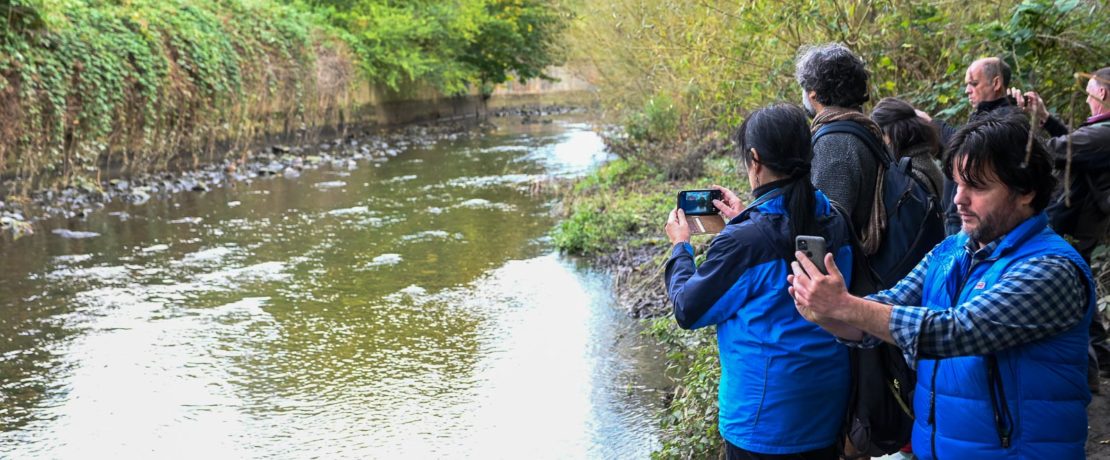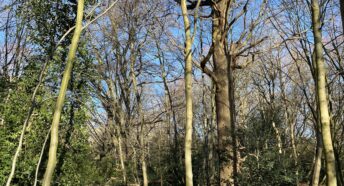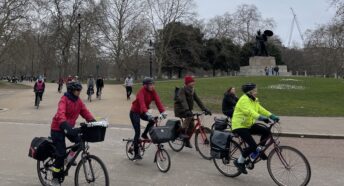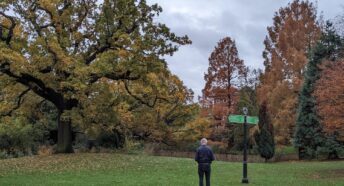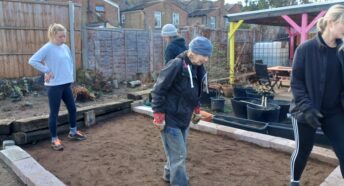London Rivers Week – A walk along the Ravensbourne
A walk along the Ravensbourne river By Peter Coles (photographs by Dan McCurry – https://www.danmccurry.com)
On the second day of this year’s London Rivers Week (Sunday 24th October), around 25 of us gathered in what must be one of the capital’s smallest and least known parks – Confluence Park, right next to Lewisham rail, DLR and bus stations. It is here, in a triangular clearing flanked on all three sides by towering buildings, that two equally little-known London rivers – the Ravensbourne and the Quaggy – join forces.
For the next couple of miles, they flow north together as the Ravensbourne, finally becoming Deptford Creek before emptying into the Thames. The Quaggy comes in from the east, while the Ravensbourne rises almost due south of Lewisham outside Bromley, in woodland on Keston Common. For anyone versed in the ancient Chinese art of Feng Shui, it is a tribute to the power of this little confluence that it has recently been “de-culverted” and restored to something like a wild state. It may be a tiny park, but I find it magical.
From here we took a short walk under the railway bridge to the (east) bank of the Ravensbourne, past what is now Tesco’s car park to the Silkworks apartment buildings. This is where, for around 600 years, a watermill stood. The car park used to be the mill pond, providing a head of water to drive waterwheels installed over the centuries. Rather like the Cheshire Cat’s smile, all that’s left of the mill today is a pair of high gateposts.
At first used by Tudor monarchs to finish and polish armour for jousts at Placentia palace (Greenwich), the mill was later used in making swords and muskets until 1824 when it was refurbished to become the Lewisham Silk Mill. Into the early 20th century the Mill earned a reputation for ‘throwing’ imported raw silk thread, cleaning and twisting into finished thread suitable for dyeing and weaving as part of England’s celebrated silk textile industry. It also specialised in producing fine silver and gold thread and, later, tinsel.
Having crossed the river by the Elverson DLR footbridge we spent some time in Brookmill Park, also lovingly restored. We were fortunate in having three Friends of Brookmill Park with us who could add details about the park, and the history of the river here. We learned that Elver(son) refers to the juvenile (‘glass’} eels that reproduce in the Thames catchment, having migrated on the currents from the Sargasso Sea.
The park was created by filling in reservoirs that used to hold drinking water – to be pumped by the handsome pumping station still standing, and in use, on the opposite bank. If you’re lucky (we weren’t) you can see the blue flash of a kingfisher speeding over the water here.
Our next stop was Deptford Bridge, once a ‘deep ford’ on the Roman road from Dover to London (Watling Street). Here, until not that long ago, there were tidal mills, powered by the head of water created by the rising and falling tide and used to grind corn. As the tide comes in, the Ravensbourne appears to be flowing backwards.
The penultimate stop was on Ha’penny Hatch Bridge, where a toll footbridge used to stand to enable pedestrians to avoid a very long walk when moving between Deptford and Greenwich. The little bridge is overshadowed by a massive, mechanical, iron lift bridge carrying the railway, which used to be raised by 12 men when a tall boat needed to enter or exit the docks in the Creek.
Our walk came to an end where the waters of the Ravensbourne – inextricably mixed with those of the Quaggy and the Pool (another tributary) – finally enter the Thames. Once dominated by a power station, chemical and gas works, a brewery and (since Tudor times) the Royal dockyard, the shores of the Creek are now home to residential and retail developments. The Feng Shui power of this confluence hasn’t been lost on the Russian consulate, though, which has erected a statue of Peter the Great here, commemorating his brief stay as a student of naval architecture in the late 17th century.
With many thanks for photographs of the walk taken by Dan McCurry – see https://www.danmccurry.com/ – for more information.
